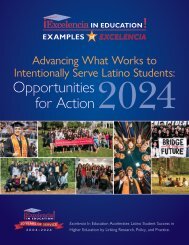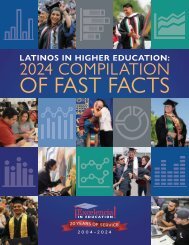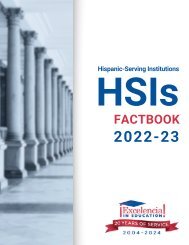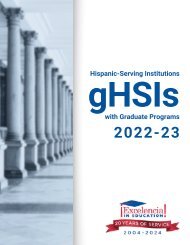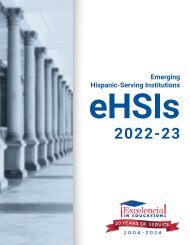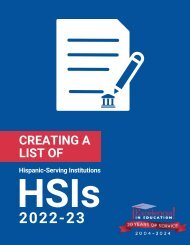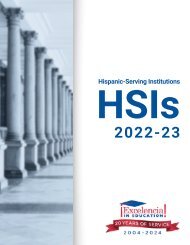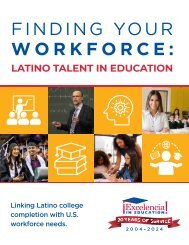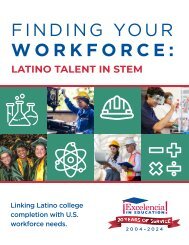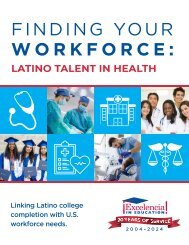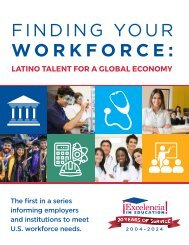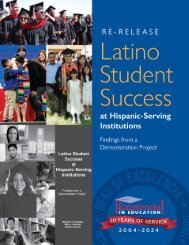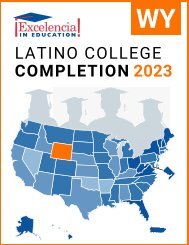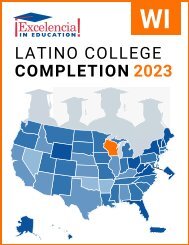Latino College Completion 2023: Illinois
You also want an ePaper? Increase the reach of your titles
YUMPU automatically turns print PDFs into web optimized ePapers that Google loves.
IL
LATINO COLLEGE COMPLETION:<br />
ILLINOIS – <strong>2023</strong><br />
For the U.S. to regain the top ranking in the world for college degree<br />
attainment, <strong>Latino</strong>s will need to earn 6.2 million degrees by 2030. 1<br />
FAST FACTS<br />
STATE RANKING:<br />
<strong>Illinois</strong> had the 6th largest<br />
<strong>Latino</strong> population in the U.S.<br />
K-12 POPULATION:<br />
In <strong>Illinois</strong>, 24% of the K-12<br />
population was <strong>Latino</strong>. 2<br />
POPULATION:<br />
In <strong>Illinois</strong>, 18% of the population<br />
was <strong>Latino</strong>. 2<br />
MEDIAN AGE:<br />
The median age<br />
of Hispanics in<br />
<strong>Illinois</strong> was 30,<br />
compared to 43<br />
for White non-<br />
Hispanics. 2<br />
30<br />
Hispanics<br />
43<br />
White<br />
non-Hispanics<br />
ENROLLMENT:<br />
In <strong>Illinois</strong>, 21% of Hispanics (ages<br />
18 to 34) were enrolled in higher<br />
education, compared to 23% of<br />
White non-Hispanics. 2<br />
DEGREE ATTAINMENT:<br />
In <strong>Illinois</strong>, 25% of Hispanic<br />
adults (25 and older) had earned an<br />
associate degree or higher, compared to<br />
50% of White non-Hispanic adults. 2<br />
Hispanic Adults = 2.5 of 10<br />
To reach the degree attainment goal by 2030, the U.S. can: close<br />
the degree completion gap by accelerating <strong>Latino</strong> completion while<br />
increasing for all students and scale up programs and initiatives that<br />
work for <strong>Latino</strong>, and all, students. The following demographics,<br />
institutional data, and practices inform <strong>Latino</strong> degree attainment.<br />
ENROLLING: Top 5 Institutions (Hispanic Undergraduates) in <strong>Illinois</strong>, 2021-22<br />
Institution<br />
Sector<br />
Grand<br />
Total<br />
NOTE: We use the terms <strong>Latino</strong> and Hispanic interchangeably in this factsheet.<br />
Hispanic<br />
Total<br />
Source: Excelencia in Education analysis using U.S. Department of Education, National Center for<br />
Education Statistics (NCES), Integrated Postsecondary Education Data System (IPEDS), 2021 Fall<br />
Enrollment, Graduation Rates Survey and Institutional Characteristics Survey.<br />
%<br />
Hispanic<br />
1 University of <strong>Illinois</strong> Chicago Public, 4-year 22,011 7,811 35%<br />
2 University of <strong>Illinois</strong> Urbana-Champaign Public, 4-year 33,889 4,759 14%<br />
3 <strong>College</strong> of DuPage Public, 2-year 14,801 4,079 28%<br />
4 <strong>College</strong> of Lake County Public, 2-year 9,124 3,980 44%<br />
Private not-forprofit,<br />
4-year<br />
5 DePaul University<br />
14,059 3,093 22%<br />
ASSOCIATE DEGREES: Top 5 Institutions Awarding to Hispanics in <strong>Illinois</strong>, 2020-21<br />
Institution<br />
Sector<br />
Grand<br />
Total<br />
Hispanic<br />
Total<br />
%<br />
Hispanic<br />
City <strong>College</strong>s of Chicago-Harold<br />
1 Washington <strong>College</strong><br />
Public, 2-year 1,283 637 50%<br />
City <strong>College</strong>s of Chicago-Wilbur Wright<br />
2 <strong>College</strong><br />
Public, 2-year 898 538 60%<br />
3 <strong>College</strong> of DuPage Public, 2-year 2,223 530 24%<br />
4 William Rainey Harper <strong>College</strong> Public, 2-year 1,921 475 25%<br />
5 <strong>College</strong> of Lake County Public, 2-year 1,233 432 35%<br />
BACHELOR DEGREES: Top 5 Institutions Awarding to Hispanics in <strong>Illinois</strong>, 2020-21<br />
Grand Hispanic %<br />
Institution<br />
Sector<br />
Total Total Hispanic<br />
1 University of <strong>Illinois</strong> Chicago Public, 4-year 4,974 1,474 30%<br />
Private forprofit,<br />
4-year<br />
2 Chamberlain University-<strong>Illinois</strong><br />
8,124 1,061 13%<br />
3 University of <strong>Illinois</strong> Urbana-Champaign Public, 4-year 8,301 944 11%<br />
Private not-forprofit,<br />
4-year<br />
4 DePaul University<br />
3,335 610 18%<br />
5 Northern <strong>Illinois</strong> University Public, 4-year 3,003 567 19%<br />
White Adults = 5.0 of 10<br />
1 Projections to 2030: Excelencia in Education. (2020). Ensuring America’s Future: Benchmarking <strong>Latino</strong><br />
<strong>College</strong> <strong>Completion</strong> to 2030. Excelencia in Education. Washington, D.C.<br />
2 U.S. Census Bureau, 2021 American Community Survey 1-Year Estimates
<strong>Illinois</strong> Gap in Degree <strong>Completion</strong><br />
Closing the degree completion gap can be tracked<br />
by the 4 measures shown below. Alone, none<br />
of these measures capture the entire “story” of<br />
degree completion. However, in combination,<br />
they provide a useful picture of the gap in degree<br />
attainment between Hispanic and White non-<br />
Hispanic cohorts in a single year.<br />
Graduation Rate — Total percentage of students<br />
who graduated within 150% of normal time for<br />
first-time, full-time freshmen. This incorporates<br />
students that graduated in 3 years at two-year<br />
institutions, or in 6 years at four-year institutions.<br />
Transferred to Another Institution —<br />
Percentage of students that transferred to another<br />
institution and did not complete a degree.<br />
Still Enrolled — Percentage of students that are<br />
still enrolled at the point of 150% normal time to<br />
completion.<br />
No Longer Enrolled — Percentage of students<br />
that are no longer enrolled at the point of 150%<br />
normal time to completion.<br />
At two-year institutions, Hispanics’<br />
graduation rate was 11%-points<br />
lower than that of their White<br />
non-Hispanic peers in <strong>Illinois</strong>.<br />
TWO-YEAR INSTITUTIONS<br />
32%<br />
9%<br />
19%<br />
40%<br />
WHITE<br />
-11%<br />
44%<br />
14%<br />
13%<br />
29%<br />
HISPANIC<br />
DEGREE OUTCOMES<br />
■ No Longer Enrolled<br />
■ Still Enrolled<br />
■ Transferred to<br />
Another Institution<br />
■ Graduation Rate<br />
*Percentages may not add up to 100% due to rounding.<br />
At four-year institutions, Hispanics’<br />
graduation rate was 14%-points<br />
lower than that of their White<br />
non-Hispanic peers in <strong>Illinois</strong>.<br />
FOUR-YEAR INSTITUTIONS<br />
WHITE<br />
-14%<br />
HISPANIC<br />
NOTE: Outcomes shown are for students at two-year institutions who started in Fall 2018, and<br />
for students at four-year institutions who started in Fall 2015.<br />
Source: Excelencia in Education analysis using the U.S. Department of Education, National<br />
Center for Education Statistics (NCES), Integrated Postsecondary Education Data System, 2021<br />
Graduation Rates Survey and the Institutional Characteristics Survey.<br />
1%<br />
22%<br />
7%<br />
70%<br />
2%<br />
34%<br />
8%<br />
56%<br />
Examples of What Works for <strong>Latino</strong> Students<br />
There are institutions showing success in enrolling, retaining, and graduating <strong>Latino</strong> students. The following are examples of<br />
programs across the country with evidence of effectiveness in serving <strong>Latino</strong> students nominated for Examples of Excelencia.<br />
The mission of Cardinal First at North Central <strong>College</strong> in <strong>Illinois</strong> is to<br />
1) provide a supportive and welcoming community for first-generation<br />
college students and their families, 2) provide a campus culture that<br />
recognizes and celebrates first-generation student identity as an asset,<br />
and 3) provide a program that intentionally connects students to<br />
faculty, resources, information and experiences that promote academic<br />
and personal success from enrollment through graduation. Cardinal<br />
First prioritizes retention across all four years through cohort-based,<br />
interactive monthly workshops (offered at multiple times) for all<br />
first-gen students from first-year students to seniors. Each one-hour<br />
workshop includes food and fellowship, first-gen faculty sharing, peer<br />
mentoring, and asset-based, student success content. To incentivize<br />
participation, a meal is provided at every workshop and a renewable<br />
$1,000 scholarship is awarded to students meeting the participation<br />
requirements. Intrusive outreach is ongoing to all first-gen students and<br />
families (in Spanish as needed).<br />
Average first-to-second year retention:<br />
• Is higher for all students in Cardinal First (92%) compared to all students<br />
(78%) and first-gen students not in the program (61%)<br />
• Is higher for <strong>Latino</strong> students in Cardinal First (89%) compared to all <strong>Latino</strong><br />
students (72%) and <strong>Latino</strong> first-gen students not in the program (52%)<br />
Average first-to-third year retention:<br />
• Is higher for all students in Cardinal First (84%) compared to all students<br />
(71%) and first-gen students not in the program (53%)<br />
• Is higher for <strong>Latino</strong> students in Cardinal First (85%) compared to all <strong>Latino</strong><br />
students (69%) and <strong>Latino</strong> first-gen students not in the program (47%)”<br />
For more information on institutional programs improving <strong>Latino</strong> student success in higher education, access Excelencia in<br />
Education’s Growing What Works database at http://www.edexcelencia.org/growing-what-works<br />
ENSURING AMERICA’S FUTURE BY INCREASING LATINO COLLEGE COMPLETION • WWW.EDEXCELENCIA.ORG




